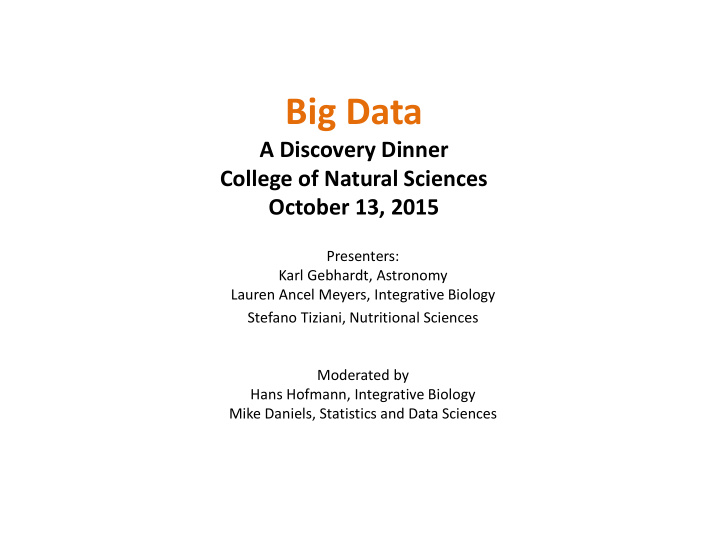



Big Data A Discovery Dinner College of Natural Sciences October 13, 2015 Presenters: Karl Gebhardt, Astronomy Lauren Ancel Meyers, Integrative Biology Stefano Tiziani, Nutritional Sciences Moderated by Hans Hofmann, Integrative Biology Mike Daniels, Statistics and Data Sciences
The upgraded HET Hobby-Eberly Telescope Dark Energy Experiment (Karl Gebhardt, Project Scientist)
HETDEX is: → Blind spectrographic survey on 10m Hobby-Eberly Telescope → About 1 million galaxies around 10 billion years ago → About 2 million galaxies within 4 billion years ago → New instrument VIRUS with 33,500 fibers over focal plane → Generate about 0.3 Pb/yr for 5-10 years → Goal is to measure the expansion rate of Universe. Data Issues: → Transfer, real-time analysis, storage on TACC → Access to a broad community → Develop techniques for understood processes and new exploratory studies
ESSENCE of HETDEX 380,000 years after the Big Bang There is a characteristic scale imprinted in the distribution of matter. It acts like a fingerprint that we use to trace over cosmic time. Requires about one million galaxies in order to see it. Today: 13.7 billion years after the Big Bang
HETDEX Analysis Issues How to handle many Pb of data. We are working with TACC on this. All data will be public. Base programs are all in c++, with python wrappers for metadata and access. Need developers who understand statistics, astrophysics, coding. As is always the issue, large-scale systematics will be the limiting factor for the uncertainties. Example case: We will have 1e6 objects detected. We will have 1e9 spectra of blank sky. Correlate detections against blank sky to pull out spatial signal from fainter sources. Example case: Detection of cosmic web, which is correlation over full region (3 Pb) of unknown pattern. Example case: Real-time analysis to look for supernovae, requires fast transfer, analysis, and feedback.
Big data and the race to stop global pandemics Lauren Ancel Meyers Department of Integrative Biology Department of Statistics & Data Sciences The University of Texas at Austin
Where are outbreaks spreading today?
Where will they be tomorrow?
How can we stop them?
The Tiziani Research Group To obtain a metabolic signature of clinical samples Early detection • Disease stratification • Disease progression • Therapy outcome • To identify novel top-hit most effective compound combinations for targeting the tumor microenvironment To better understand cellular metabolism and its link to human diseases
The Tiziani Research Group This urine wheel was published in 1506 The Metabolome by Ulrich Pinder, in his book Epiphanie Medicorum used to diagnose disease
Targeting the Metabolome is Challenging This image cannot currently be displayed. 10 2 Metabolites/lipids validated 10 3 Metabolites/lipids potentially identified 10 4 10 5 Thousands of features Not detectable yet… 10 6
Stable Isotope Assisted-Metabolomics 13 C 1 H
High-Throughput Screening • (e.g. ATP and ROS assays 384 well plate) High-Content NMR- and MS-based • metabolic screening (96 well plate, flasks) NMR- and MS-based metabolic • studies (intra- and extra-cellular) Metabolic fluxes analysis • • Constraining simulations • 13 C, 15 N labeled nutrient
Recommend
More recommend